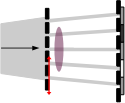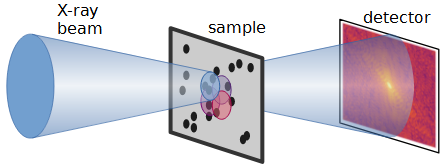BSc and MSc projects
Projects in X-ray scattering with edge illumination

X-ray imaging based on the edge-illumination principle provides an X-ray scattering signal, which originates from sample features that may be considerably smaller than a detector pixel. Thus, edge-illumination is a scattering technique that truely allows for sub-pixel imaging, i.e., sensitivity towards micrometer and sub-micrometer features with pixels sizes of tens of micrometers and larger. The experimental setup is located in our X-ray laboratory at the Emmy Noether campus.
Characterisation of defects in composite materials with X-ray scattering
Modern composite materials offer the potential to replace metals such as aliminium or steel in car manufactoring, which leads to a substantial decrease of the vehicle's weight and, thus, fuel saving. The occurence and evolution of defects in composite materials is yet poorly understood, which poses safety concerns. The goal of this project is to determine if X-ray scattering with edge illumination can be a useful method to investigate the defect mechanisms of composite materials. This will be done by experimental obtaining the X-ray scattering signal of various defect kinds and subsequent basic data analysis. Improvement of the scan procedures would be very beneficial.
- Suitable for: MSc Nanoscience & BSc Physics
- Beneficial skills: experience in conducting experiments, knowledge in x-ray imaging, programming (python or other languages),
- Location: University of Siegen
- Contact: Dr. Özgül Öztürk, oezguel.oeztuerk@uni-siegen.de & Jun.-Prof. Dr. Peter Modregger, peter.modregger@uni-siegen.de
Sensitivity optimisation of X-ray scattering experiments with edge illumination
The experimental setup for edge illumination has a large number of free parameters including the distances between optical elements, X-ray source settings and the aperture size of the utilised masks. This project is aimed at investigating this parameter space with respect to sensitivitiy towards the scattering signal and, ideally, to identify optimal experimental parameters. This will be done mainly with numerical simulations in python and a few supporting experiments.
- Suitable for: MSc Physics & MSc Nanoscience
- Beneficial skills: programming (python or other languages), knowledge in x-ray imaging
- Location: University of Siegen
- Contact: Dr. Özgül Öztürk, oezguel.oeztuerk@uni-siegen.de & Jun.-Prof. Dr. Peter Modregger, peter.modregger@uni-siegen.de

X-ray ptychography is a cutting-edge imaging technique that provides spatial resolutions down to a few nanometers. In the experiment, the X-ray beam is focused on the sample and the resulting far-field diffraction pattern is recorded by a detector. The idea of ptychography is then to scan the sample in the lateral directions and to measure the diffraction patterns from overlapping sample exposures. This yields redundant information about sample features, which are smaller than the focal spot size (~ 100 nm). Using iterative optimisation algorithms for data analysis leads to ptychographic reconstructions with record-holding spatial resolutions. X-ray ptychography provides researchers from a wide variety of fields with an exciting new tool for investigating the inner structure of micro-meteorites, growth mechanisms of cancerous cells or defects in modern nano-materials.
Performance comparison of two ptychographic reconstruction algorithms
This project is aimed at the characterisation of at least two ptychographic reconstruction algorithms in terms of noise transfer, provided contrast to noise ratios and speed. This will be achieved by using wave optics-based numerical simulations for generating artificial data, using real world experimental data and ptychographic reconstruction with a pre-existing code base. Participation in a synchroton experiment may be possible.
- Suitable for: MSc Physics & MSc Nanoscience
- Beneficial skills: programming (python or other languages), knowledge in x-ray imaging
- Location: DESY, Hamburg (USiegen may be possible)
- Contact: Jun.-Prof. Dr. Peter Modregger, peter.modregger@uni-siegen.de
Computational complexity of standard ptychographic reconstruction
This goal of this project is to determine the computational complexity of the standard ptychographic reconstruction algorithm. This entails the determination of the speed of the algorithm as a function of number of experimental data points and noise. The student will use wave optics-based numerical simulations for generating artificial data and ptychographic reconstruction with a pre-existing code base. The results will be used to determine the feasibility of algorithmic improvements.
- Suitable for: BSc Physics
- Beneficial skills: programming (python or other languages), knowledge in x-ray imaging
- Location: DESY, Hamburg or University of Siegen
- Contact: Jun.-Prof. Dr. Peter Modregger, peter.modregger@uni-siegen.de
